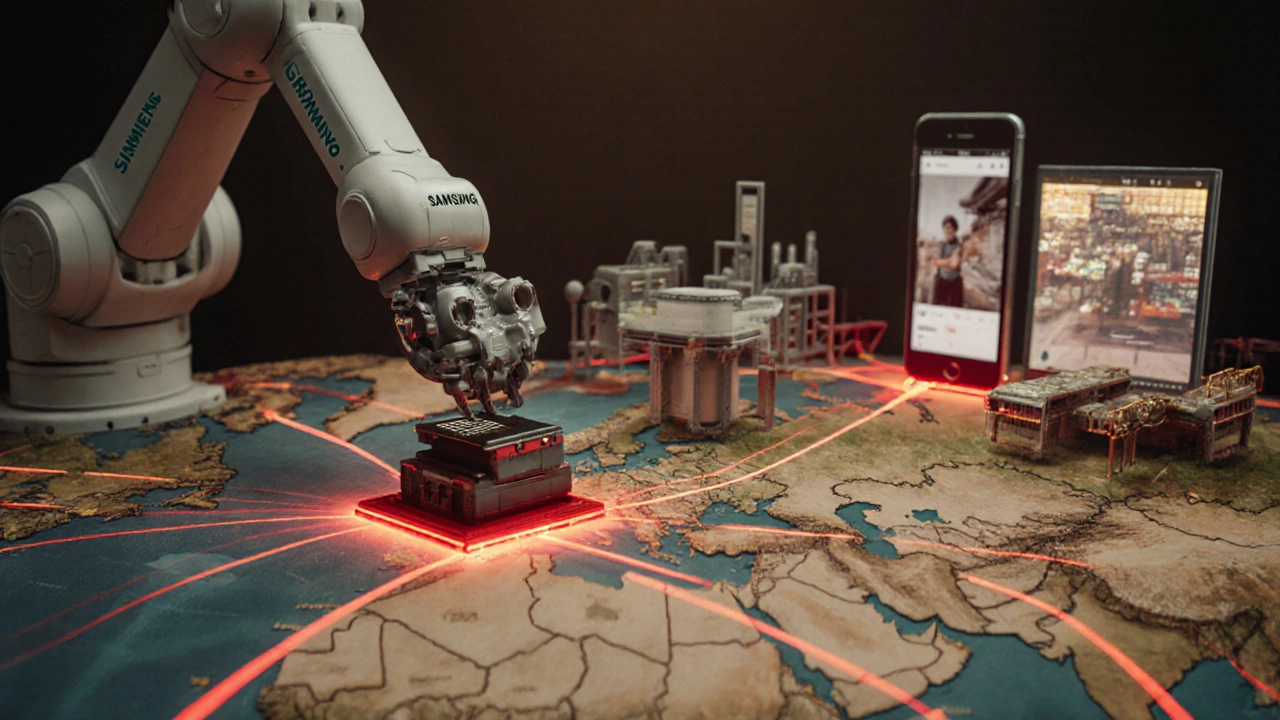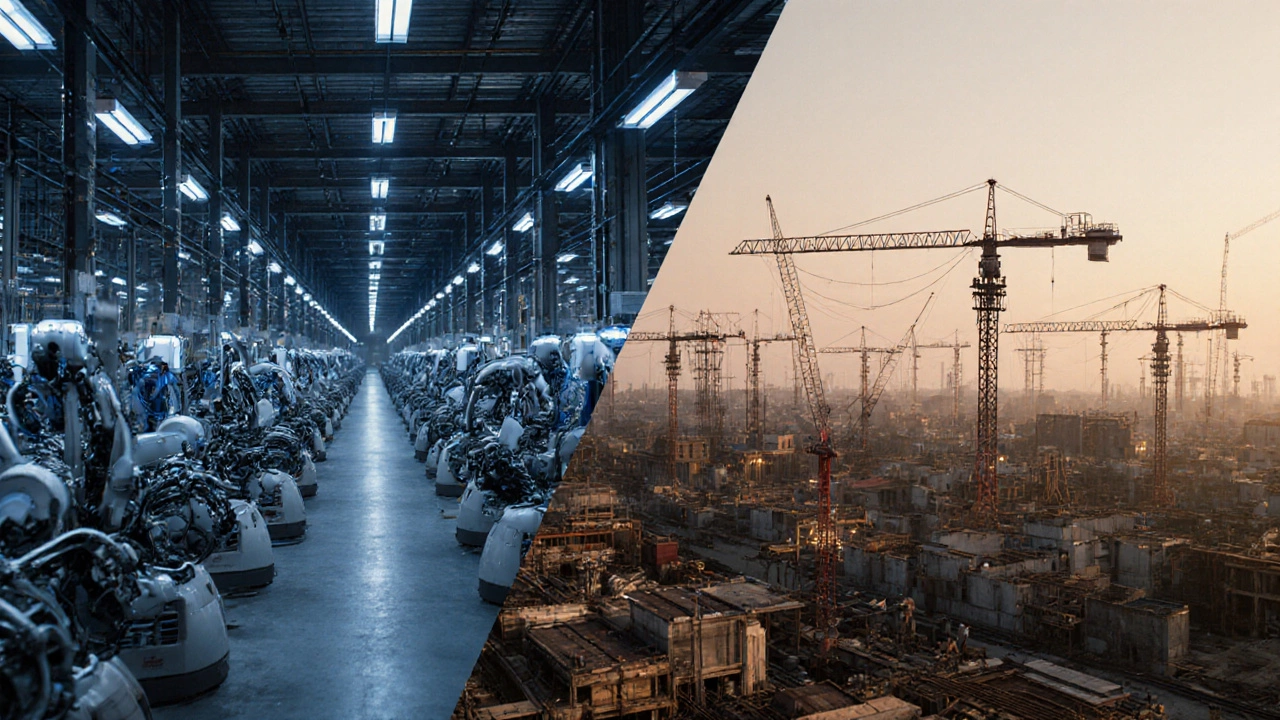Manufacturing Power Index Calculator
How Manufacturing Dominance is Measured
Based on the article's framework, we calculate a weighted score for each country using four key factors:
- Scale Production volume
- Integration Supply chain efficiency
- Technology Industrial automation
- Policy Government support
| Rank | Country | Score |
|---|
Key Insights
When you think of manufacturing, you might picture factories, robots, or assembly lines. But the real question isn’t just about machines-it’s about scale, control, and influence. Who actually runs the world’s manufacturing engine? And why does it matter who’s on top?
China Is the World Leader in Manufacturing
China is the world leader in manufacturing, producing nearly 30% of all global industrial output. That’s more than the next three countries combined. In 2024, China’s manufacturing value added hit $5.3 trillion, according to the World Bank. That’s not a small lead-it’s a gap wider than the entire economy of Germany or Japan.
China doesn’t just make more stuff-it makes almost everything. From smartphones and solar panels to textiles and electric vehicles, Chinese factories churn out components and finished goods at speeds and volumes no other country can match. The country has over 40 million workers in its manufacturing sector, and its supply chain infrastructure spans thousands of industrial parks, ports, and logistics hubs.
It’s not just about labor costs anymore. China’s advantage comes from deep integration: raw materials arrive, get processed, assembled, and shipped-all within a few hundred miles. A phone made in Shenzhen might have a battery from Guangdong, a screen from Wuhan, and a chip from Shanghai, all assembled in the same city and shipped out the next day.
How China Built Its Manufacturing Empire
China didn’t become the leader overnight. It started in the 1980s with special economic zones that offered tax breaks, cheap land, and relaxed regulations. Foreign companies like Apple, Nike, and Siemens set up shop because China offered something no one else could: predictable output at low cost.
By the 2000s, China had invested heavily in infrastructure-high-speed rail, deep-water ports, and automated warehouses. It also trained millions of engineers and technicians. Today, China produces more than 80% of the world’s smartphones, 70% of its electronics, and over 60% of its textiles.
Even in high-tech areas like batteries and solar panels, China dominates. It controls over 80% of the global supply of lithium-ion battery components and produces nearly 95% of the world’s solar panels. This isn’t luck-it’s strategy. The Chinese government identifies key industries, pours billions into R&D, and then backs domestic companies like BYD, Huawei, and CATL to dominate global markets.
Who Are the Other Major Players?
While China leads, it’s not alone. Other countries hold strong positions in specific sectors.
United States leads in high-value manufacturing: aerospace, pharmaceuticals, semiconductors, and advanced machinery. Companies like Boeing, General Electric, and Intel still design and produce some of the most complex products on earth. The U.S. accounts for about 15% of global manufacturing output, but it earns more profit per unit than any other country.
Germany is the powerhouse of precision engineering. It’s home to Siemens, Bosch, and Volkswagen, and it specializes in industrial automation, automotive parts, and machine tools. German manufacturers are known for quality over quantity. They make the robots that build cars, the turbines that power wind farms, and the medical devices used in hospitals worldwide.
Japan remains a leader in robotics, electronics components, and automotive engineering. Companies like Toyota, Sony, and Panasonic still set global standards for reliability and efficiency. Japan’s manufacturing is less about volume and more about refinement-perfecting processes until they’re nearly flawless.
South Korea dominates memory chips (Samsung and SK Hynix make over 70% of the world’s DRAM), displays, and shipbuilding. Its manufacturing is tightly tied to global tech supply chains.
India is growing fast. With government incentives and lower labor costs, it’s becoming a major hub for electronics assembly and pharmaceuticals. Foxconn now runs massive iPhone production lines in Tamil Nadu, and Indian drugmakers supply over 20% of the world’s generic medicines.

What Makes a Country a Manufacturing Leader?
It’s not just about how many factories you have. Real leadership comes down to four things:
- Scale-Can you produce millions of units a year? China wins here.
- Integration-Do your suppliers, factories, and ports work as one system? China’s supply chain density is unmatched.
- Technology-Are you building the tools others use? Germany and Japan lead in industrial automation.
- Policy-Does your government support manufacturing with funding, training, and infrastructure? China’s five-year plans have shaped its dominance for decades.
Other countries can compete in niche areas. But no one else has matched China’s ability to combine all four at once.
Is China’s Lead Safe? Challenges Ahead
China’s dominance isn’t unchallenged. Rising labor costs, aging workers, and environmental pressures are pushing some companies to move production to Vietnam, India, or Mexico. The U.S. and EU are also pushing “friend-shoring”-moving supply chains to allied countries to reduce dependence on China.
Still, shifting production isn’t easy. Building a new factory takes years. Training workers takes longer. And no country has China’s network of suppliers. Even if a company moves assembly to Vietnam, it often still buys components from China.
China is also investing heavily in automation. Factories in Guangdong now run with 90% fewer workers than a decade ago. Robots don’t get tired. They don’t demand raises. And they don’t strike.

What This Means for Businesses and Consumers
If you’re a business, understanding who leads manufacturing helps you make smarter choices. Need cheap, high-volume parts? China is still your best bet. Need high-precision components for medical devices? Germany or Japan might be better. Need fast turnaround for custom orders? Look to local manufacturers in the U.S. or Eastern Europe.
For consumers, it means your phone, your clothes, your car, and even your medicine likely came from a Chinese factory. That’s not a bad thing-it’s just reality. The world runs on中国制造 (Made in China).
But that’s changing slowly. More companies are now building dual supply chains-one for volume (China), one for resilience (India, Mexico, Eastern Europe). The future won’t be about one country dominating. It’ll be about a network of players, each with their own strengths.
Who Will Be the Next Leader?
Right now, no country is close to replacing China as the overall leader. But India is the most likely contender. With a young population, growing infrastructure, and strong government support, India could become the second-largest manufacturing hub by 2035.
However, even if India matches China’s output, it won’t replicate China’s ecosystem. The real question isn’t who replaces China-it’s whether the world can afford to lose it. Because when China slows down, the whole world feels it.
Is China still the top manufacturer in 2025?
Yes, China remains the world’s top manufacturer in 2025, accounting for nearly 30% of global manufacturing output. Its production of electronics, machinery, textiles, and electric vehicles continues to outpace every other country, and its integrated supply chains remain unmatched.
Which country has the most advanced manufacturing technology?
Germany leads in advanced manufacturing technology, especially in industrial automation, precision machinery, and robotics. Companies like Siemens and Bosch design the systems that power factories worldwide. Japan and South Korea also rank highly in robotics and electronics manufacturing tech.
Why is China’s manufacturing so dominant?
China’s dominance comes from a mix of scale, speed, and integration. It has thousands of specialized industrial zones, a vast workforce, and a supply chain where parts, assembly, and shipping happen in the same region. Government support, decades of infrastructure investment, and massive scale make it cheaper and faster to produce almost anything there.
Can the U.S. overtake China in manufacturing?
It’s unlikely the U.S. will overtake China in total output. But the U.S. leads in high-value manufacturing like aerospace, semiconductors, and pharmaceuticals. The goal isn’t to match China’s volume-it’s to control the most profitable and strategic parts of production.
Is India becoming a manufacturing superpower?
India is growing rapidly in electronics and pharma manufacturing, thanks to government incentives and lower labor costs. Companies like Apple and Samsung are expanding production there. But India still lacks China’s supply chain depth and industrial density. It’s on track to be the second-largest manufacturer by 2035, but it won’t surpass China in the near future.
